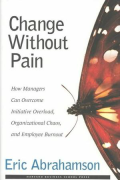My Account
Subscriptions
Summary Categories
Summary Collections
- Career & Life Satisfaction Collection
- Disruptive Innovation Collection
- Exceptional Leadership Collection
- Great Employees Only Collection
- Hidden Gems Collection
- Marketing Collection
- Must-Read Books for 2012 v1
- Must-Read Books for 2012 v2
- Must-Read Books for 2013
- Self-Help Collection
- Small Business Collection
- Strategic Assessment Collection
- Strategic Genius Collection
- Take Charge Collection
- Team Management Collection
- Ultimate Sales Collection
- Web Marketing Collection
Summary List
Change Without Pain:How Managers Can Overcome Initiative Overload, Organizational Chaos, and Employee Burnout
Eric Abrahamson
Summarized June 2004
Type: [SUMMARY]
SKU: 6041
ISBN: 157851827X
Price: $12.50
Available Formats:




Purchase Summary
Summary Description
Globalization, the advance of technology, and powerful demographic and psycho-graphic forces are forcing our businesses to change or die. Unfortunately for many businesses, it‘s actually becoming a matter of change and die. If you‘re typical, you need look no further than your office door to see this happening right before your eyes. How many change initiatives has your company been through? How many CEOs have come and gone? How many new IT systems has your business installed? Most important: Have any of these changes actually improved profits and performance? If your company is like most, the relentless push for change has often done more harm than good - and it has taken a tremendous toll on your finances and your people. In Change Without Pain, Columbia Business School professor Eric Abrahamson asserts that while companies need change to grow and prosper, they don‘t need the pain that often comes with it. He outlines a new approach to change, called “creative recombination,” that stands in sharp contrast to the “creative destruction” advocated by change champions for the past two decades. In this summary you‘ll learn about “creative recombination,” a way to achieve change by putting existing assets to new uses rather than destroying the old and inventing something new. You‘ll see the benefits of an approach that calls for smaller-scale, well-paced changes that can be done more cheaply, more quickly, and with a lot less pain, instead of forcing radical, sweeping change on the organization.
 Member Log In
Member Log In